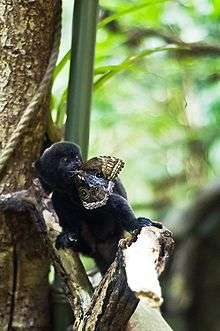Goeldi's marmoset
The Goeldi's marmoset or Goeldi's monkey (Callimico goeldii) is a small, South American New World monkey that lives in the upper Amazon basin region of Bolivia, Brazil, Colombia, Ecuador, and Peru. It is the only species classified in the genus Callimico, and the monkeys are sometimes referred to as "callimicos".
| Goeldi's marmoset[1][2] | |
|---|---|
.jpg) | |
| Scientific classification | |
| Kingdom: | Animalia |
| Phylum: | Chordata |
| Class: | Mammalia |
| Order: | Primates |
| Suborder: | Haplorhini |
| Infraorder: | Simiiformes |
| Family: | Callitrichidae |
| Genus: | Callimico Miranda Ribeiro, 1922 |
| Species: | C. goeldii |
| Binomial name | |
| Callimico goeldii Thomas, 1904 | |
 | |
| Geographic range | |
| Synonyms | |
| |
Goeldi's marmosets are blackish or blackish-brown in color and the hair on their head and tail sometimes has red, white, or silverly brown highlights.[4] Their bodies are about 8–9 inches (20–23 cm) long, and their tails are about 10–12 inches (25–30 cm) long.


Goeldi's marmoset was first described in 1904, making Callimico one of the more recent monkey genera to be described. In older classification schemes it was sometimes placed in its own family Callimiconidae and sometimes, along with the marmosets and tamarins, in the subfamily Callitrichinae in the family Cebidae. More recently, Callitrichinae has been (re-)elevated to family status as Callitrichidae.
Females reach sexual maturity at 8.5 months, males at 16.5 months. The gestation period lasts from 140 to 180 days. Unlike other New World monkeys, they have the capacity to give birth twice a year. The mother carries a single baby monkey per pregnancy, whereas most other species in the family Callitrichidae usually give birth to twins. For the first 2–3 weeks the mother acts as the primary caregiver until the father takes over most of the responsibilities except for nursing. The infant is weaned after about 65 days. Females outnumber males by 2 to 1.[4] The life expectancy in captivity is about 10 years. The monkeys are able to jump as far as one end of a tennis court to another.
Goeldi's marmosets prefer to forage in dense scrubby undergrowth; perhaps because of this, they are rare, with groups living in separate patches of suitable habitat, separated by miles of unsuitable flora. In the wet season, their diet includes fruit, insects, spiders, lizards, frogs, and snakes. In the dry season, they feed on fungi, the only tropical primates known to depend on this source of food. They live in small social groups (approximately six individuals) that stay within a few feet of one another most of the time, staying in contact via high-pitched calls. They are also known to form polyspecific groups with tamarins, perhaps because Goeldi's marmosets are not known to have the X-linked polymorphism which enables some individuals of other New World monkey species to see in full tri-chromatic vision.[5]
The species takes its name from its discoverer, the Swiss naturalist Emil August Goeldi.
References
- Groves, C. P. (2005). Wilson, D. E.; Reeder, D. M. (eds.). Mammal Species of the World: A Taxonomic and Geographic Reference (3rd ed.). Baltimore: Johns Hopkins University Press. p. 129. ISBN 0-801-88221-4. OCLC 62265494.
- Rylands AB, Mittermeier RA (2009). "The Diversity of the New World Primates (Platyrrhini)". In Garber PA, Estrada A, Bicca-Marques JC, Heymann EW, Strier KB (eds.). South American Primates: Comparative Perspectives in the Study of Behavior, Ecology, and Conservation. Springer. pp. 23–54. ISBN 978-0-387-78704-6.
- Mittermeier, R. A. & Rylands, A. B. (2008). "Callimico goeldii". IUCN Red List of Threatened Species. 2008. Retrieved 2 January 2009.CS1 maint: ref=harv (link)
- Falk, Dean (2000). Primate Diversity. W.W. Norton and Company, ISBN 0-393-97428-6.
- Surridge AK, Mundy NI (2002). "Trans-specific evolution of opsin alleles and the maintenance of trichromatic colour vision in Callitrichine primates". Molecular Ecology. 11 (10): 2157–2169. doi:10.1046/j.1365-294X.2002.01597.x. PMID 12296957.
External links



- ARKive - images and movies of the Goeldi's monkey (Callimico goeldii)
- Press release on recent research on Goeldi's monkey by scientists at the University of Washington
- Primate Info Net Callimico goeldii Factsheet
- Pictures of Goeldi's Monkey
